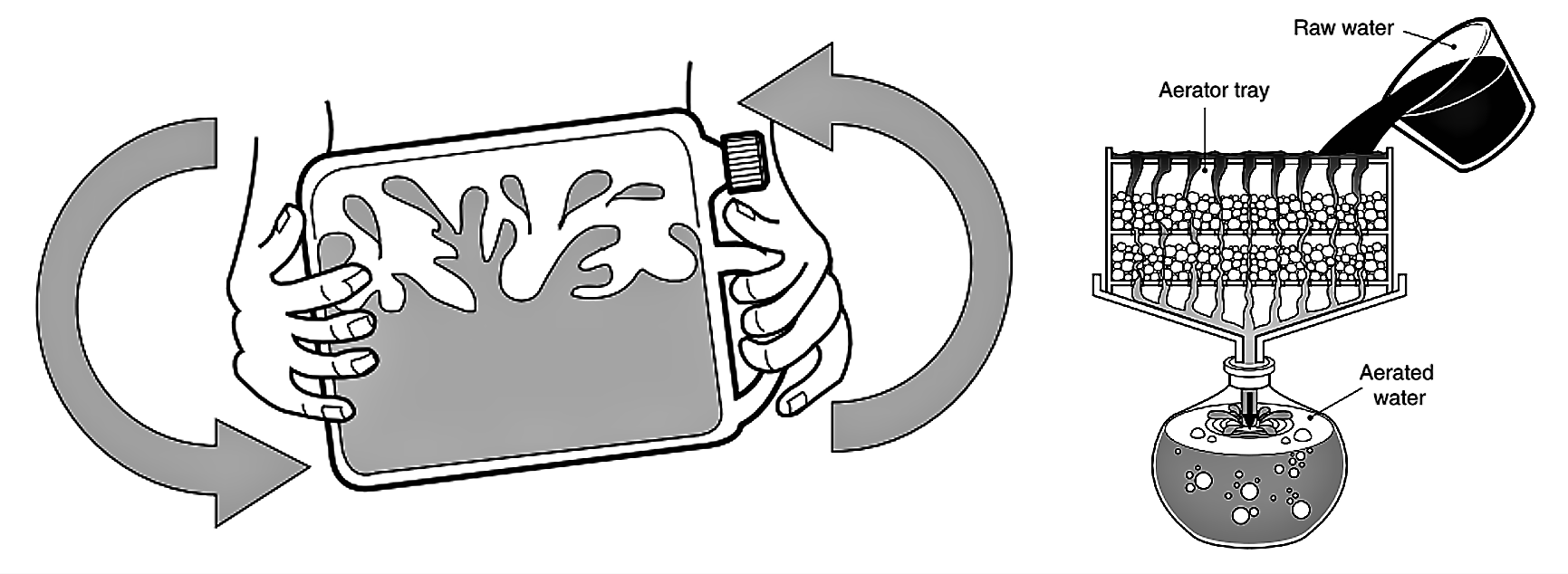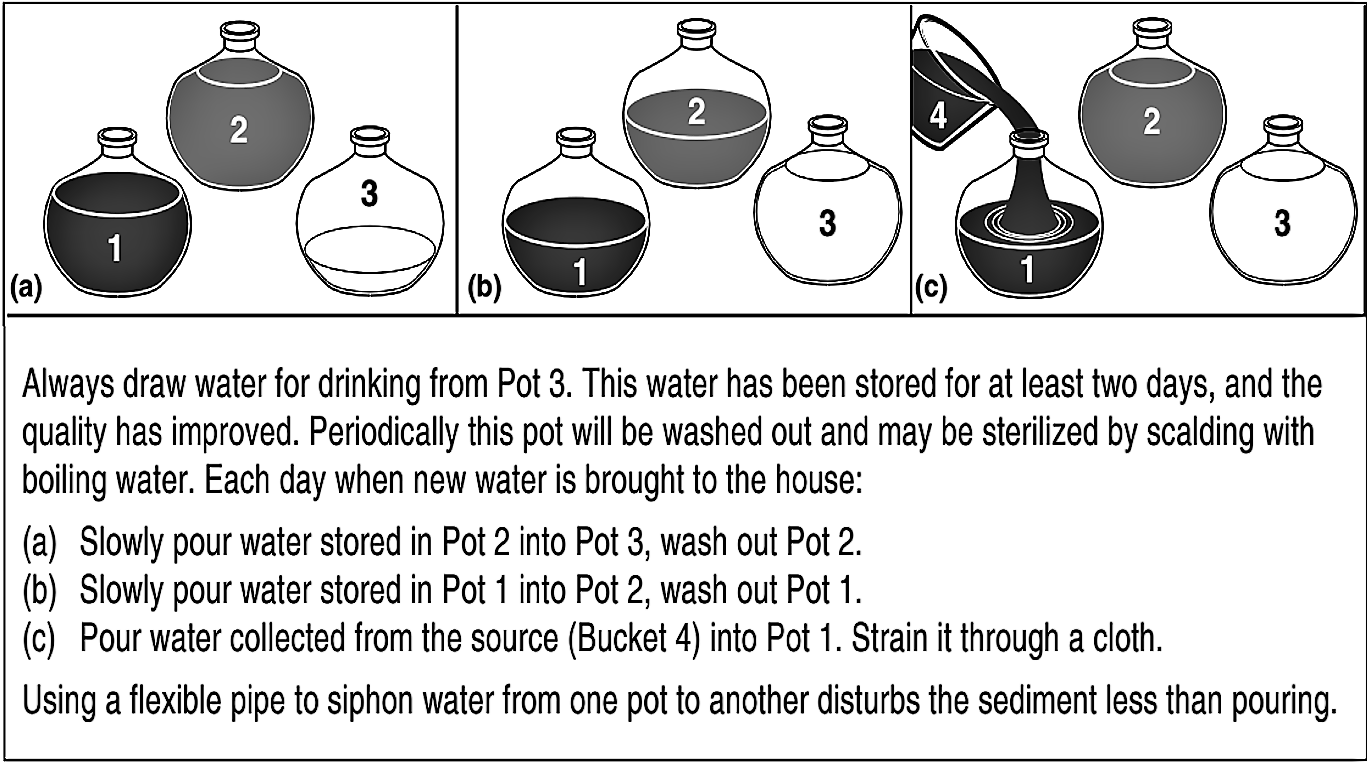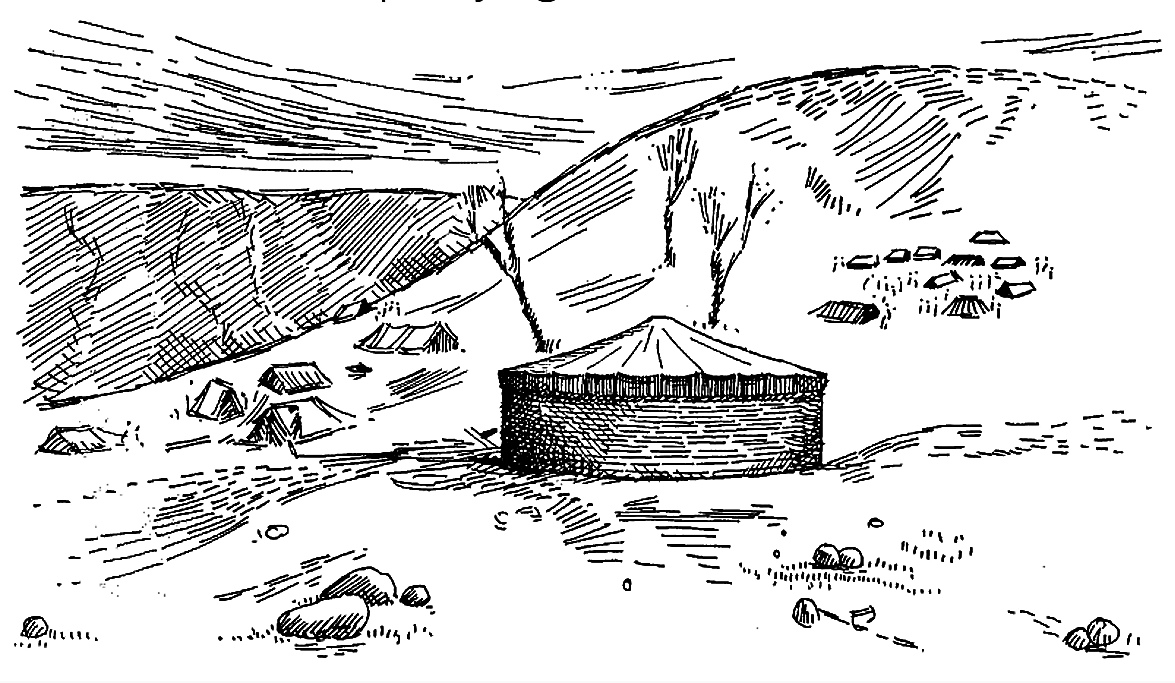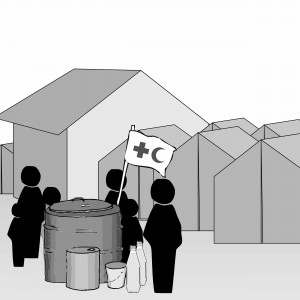Following an emergency, the affected population frequently lacks access to a safe source of drinking water. Treatment at the Point-of-Use (POU) is a simple, effective and less expensive method of providing safe drinking water to the people (compared to a semi-centralised system) provided water is available. Even though once applied the method can be quick, it is difficult to manage and it will require a lot of awareness-raising and participation of the population. Appropriateness of the promotion of POU water treatment and safe storage methods depend on the type of disaster and its impact on people’s water supplies (CLASEN & SMITH 2005).
| Entradas | Salidas |
|---|---|
Drinking Water |
Water and sanitation (see also water supply and purification in emergencies and sanitation in emergencies(see PPT)) are critical determinants for survival immediately after and during the initial stages of a disaster (GWC 2009). Therefore, the availability of sufficient clean water in the immediate aftermath of a disaster is crucial in order to take care of the sick, to provide for human consumption to maintain basic hygiene, to support search and rescue efforts, and to ensure that productive and commercial activities get back to normal.
In case of an emergency, organisations may be present in camps or in some communities taking care of drinking water quality and wastewater treatment (see also camp water supply). If this is not the case, or if people remain in their homes, water has to be taken directly from water distribution networks (which may be damaged) or from existing water sources or brought in by water tankers by the government or relief organisations. These sources might be polluted or the population does not have good hygiene behaviour or no access to clean containers for collection and storage. In this situation, promoting Point-of-Use (POU) water treatment, sometimes also referred to as household-level water treatment and safe storage (HWTS), is an effective and relatively cheap option. POU water treatment techniques can easily be carried out after a brief and basic technical training (IFRC 2008).
POU water treatment as defined by the World Health Organization as HWTS consists of 4 steps: sedimentation); filtration (see also straining and filtration, ceramic candle filters, colloidal silver filters, or biosand filters); disinfection (e.g. chlorination, boiling, solar disinfection or UV-tubes); and safe storage. HWTS is a multi-barrier approach and is ideally combined with water source protection.
POU water treatment is often a temporary measure undertaken until the water source can be improved (IFRC 2008). However, the programmatic support (e.g. management and required awareness raising and training actions) required for POU water treatment may not be available in the initial phase of a disaster response when other higher priorities out-compete in the demand for time and resources (CLASEN & SMITH 2005).
It is important to note that securing appropriate water quantity in emergencies is prior to securing water quality at a safe drinking water level. Quantity is more related to water sources selection (availability, proximity and sustainability of sufficient water quantity, see also water sources), while quality further includes treatment, hygiene promotion (see also awareness raising (see PPT)) and all aspects of water safety plans (THE SPHERE PROJECT 2011).
Adapted from: OXFAM (2001)
Groundwater will predominantly be cleaner than surface water and will have less treatment requirements. Surface water sources in rural areas will probably need treatment to address high-suspended solids and to subsequently kill off microorganisms. Removal of the suspended solids presents the greatest treatment challenge, and technologies should thus secure sustainability in the medium- to long-term. Overly complex solutions should be avoided in general. The practice of sedimentation and use of aluminium sulphate as a coagulant is the most common procedure for this step in emergencies.
Before thinking of POU water treatment, the localisation and protection of water sources is of importance (see also water source protection). In case of emergencies, existing but damaged sources may be revived, new local sources of water may be made accessible (e.g. wells, boreholes, springs, streams, ponds or rainwater) or water may be taken from existing sources from neighbouring communities (REED & SHAW 1999; see also http://wedc.lboro.ac.uk/knowledge/notes_emergencies.html for some technical notes on how to clean wells and rehabilitate existing systems).
There are two types of water sources depending on their location: those situated above consumption points (provision of water by means of gravity; allow for systems with less operation and maintenance requirements) and those situated below consumption points (water system will rely on water lifting equipment). Ideally, the site should be chosen on the basis of the suitability of the water source, but the fact that sources situated above the setting are generally less exposed to contamination by poor hygiene practice and sanitation facilities should also be considered.
The available options and procedure correspond to the general HWTS approach methods as mentioned above, with slight changes according to the circumstances of the emergency:
Pre-treatment: Aeration
Aeration brings water in close contact with air, which increases the oxygen content of the water. This will: remove volatile substances such as hydrogen sulphide and methane which affect taste and odour; reduce the carbon dioxide content of the water; oxidise dissolved minerals such as iron and manganese so that they can be removed by sedimentation and filtration.

On a larger scale, aeration may be achieved by allowing water to trickle through one or more well-ventilated, perforated trays containing small stones. Again, the water must be collected in a container and allowed to stand for about 30 minutes to settle suspended particles before disinfection (KJAERGAARD et al. 2007).
Sedimentation (see also sedimentation)
The main obstacle to the elimination of pathogenic organisms is high turbidity, as it prevents effective disinfection. If water is stored for a day in safe conditions, more than 50% of most bacteria die and suspended solids will settle to the bottom of the container. Households can maximise the benefits of storage and settlement by using the three-pot system (KAYAGA & REED 2011).

Suspended solids can be removed from water by mechanical or chemical sedimentation. This removal invariably presents the greatest treatment challenge and complex solutions should be avoided with regard to sustainability (OXFAM 2001). The chemical removal (e.g. by using Watermaker or PUR, see IFRC 2008) is especially useful in floods since turbidity is effectively removed and water disinfected. But the flocculent/coagulation and disinfection method is significantly more expensive compared to single chemical disinfection of non-turbid raw fresh water (IFRC 2008).

Alternatively, roughing filters can be applied as pre-filters to treat water of high turbidity (>50 NTU). They speed up the settlement process significantly, because particles are removed by both filtration and gravity settling. Roughing filters improve the solid removal efficiency without the use of chemicals (EAWAG 2011; OXFAM 2001; WEGELIN 1996).
Filtration
A common filtration method proposed in emergency situations is straining by pouring water through a piece of clean fabric, straining removes some of the suspended solids and is therefore an improvement for people with no other options. Filters such as ceramic filters, colloidal silver filters, and biosand filters are not commonly used in emergencies (IFRC 2008) but can be an option in some cases. In the 2004 tsunami response, Oxfam decided to deploy ceramic filters and biosand filters only in the resettlement phase when people began to re-establish their households more permanently (CLASEN & SMITH 2005). As an example of a natural filtration system, infiltration wells close to water streams will usually provide better-quality water than the water stream itself (see also river bank filtration). The sand and gravel deposited beside and below a river act as an effective water filter (REED & SHAW 1999).
Disinfection
Disinfection is used to destroy pathogenic organisms. In non-emergency situations, certain waters may not require disinfection (e.g. deep groundwater, mountain streams). However, disinfection should be used wherever possible in emergencies as an added precaution (HOUSE & REED 2004). The traditional method of boiling can provide safe drinking water in emergencies (except at high altitudes), however, it requires a lot of energy (e.g. fuel, which might be scarce) and does not remove turbidity or chemical pollution (e.g. arsenic).
The most common (chemical) disinfection method is through chlorination. When used correctly, chlorine will kill all viruses and bacteria, but some species of protozoa and helminths are resistant to chlorine. Some of the chlorine compound should remain in the water to increase the likelihood that the water will remain safe to drink during storage (KAYAGA & REED 2011; REED & SHAW 1999; WISNER & ADAMS 2002). Solar water disinfection or SODIS can be achieved by exposing fresh water to solar light (UV-A radiation) for at least six hours. It can remove bacteria, viruses and some parasites, but not chemical pollution e.g. arsenic, fluoride or agricultural residues. SODIS by using transparent PET bottles is extremely low-cost and simple. UV light is also efficient in killing most microorganisms (see also uv tubes).
Safe Water Storage
Safe storage means keeping treated water away from sources of contamination, and using a clean and covered container. It also means that water should be drunk from the container in a way that people do not make each other sick (CAWST 2009). On refugee sites, storage facilities are required in the distribution system as well as at household level (UNHCR 2007).

The 2004 earthquake and tsunami in the Indian Ocean affected coastal areas’ water supply systems. Relief organisations encouraged the affected population to treat their own water, mainly by boiling. In other areas chlorination was done with bleach (sodium hypochlorite), bleaching powder (calcium hypochlorite), chlorine tablets (NaDCC, halazone). Also PUR sachets (combined flocculent and disinfectant), and alum (flocculent) were distributed for treating water at the distribution points (see camp or community water supply) or at the household level via sedimentation. Relief organisations also began distributing vessels and utensils for collecting, storing and consuming water (CLASEN & SMITH 2005).
The limited role of household water treatment was not a result of unavailability of the technology. In fact, the quantity of products sent to the region for the purpose of treating water was remarkable. The five main reasons for not using household (POU) water treatment in the tsunami emergency response have been identified as follows (CLASEN & SMITH 2005):
- Emphasis on water quantity over quality, since physiological needs (hydration) outweigh microbiological concerns
- Bulk supply of water made POU water treatment unnecessary: the affected population was either displaced or had otherwise lost access to their customary sources of fresh water. Hence, they were dependent on water supplied in bulk.
- POU water treatment measures require programmatic support to induce behavioural change (chlorination, solar disinfection)
- Concern over conflicting messages being given to the affected populations, resulting in a decrease of normal practice (e.g. boiling in Aceh), thus leaving individuals exposed to increased risk of waterborne diseases
- Concern over sustainability of newly introduced and promoted POU water treatment methods. Short-term behaviour change without sustained promotion could be detrimental to health if it means the abandonment of previous safe drinking water practices.
Although POU approaches to water treatment have proven to be effective in development programmes, their utility in emergencies has not yet been widely demonstrated. During the immediate emergency phase, the evidence from the first three months following the 2004 Indian Ocean tsunami suggests that household water treatment may be inappropriate after a disaster of this kind (CLASEN & SMITH 2005).
POU water treatment can potentially be applied in any emergency that affects the water supply of communities and households beyond their normal coping mechanism. POU water treatment is useful when bulk water supply cannot be provided for some time e.g. due to transport capacities, lack of tanks etc. It may also be useful when affected people live rather dispersed. It requires programmatic support for people who don’t know the method yet. And it requires a minimum of water sources available. Even when water is supplied in bulk, safe water storage at household level should be promoted.
An Introduction to Household Water Treatment and Safe Storage, A CAWST Training Manual
This training manual describes the need of safe drinking water and sanitation and provides relevant information on HWTS process, technologies. It is good reference material for trainers to conduct training on HWTS.
CAWST (2009): An Introduction to Household Water Treatment and Safe Storage, A CAWST Training Manual. Calgary: Centre for Affordable Water and Sanitation Technology (CAWST) URL [Visita: 13.05.2019]The Drinking Water Response to the Indian Ocean Tsunami, Including the Role of Household Water Treatment
This study documents the drinking water response, including the role played by household water treatment after the Indian Ocean Tsunami.
CLASEN, T. SMITH, L. (2005): The Drinking Water Response to the Indian Ocean Tsunami, Including the Role of Household Water Treatment. Geneva: World Health Organization (WHO) URL [Visita: 14.07.2010]Roughing Filter Technology
The Human Right to Water and Sanitation in Emergency Situations. The Legal Framework and a Guide to Advocacy
Emergency Water Sources. Guidelines for Selection and Treatment
This comprehensive and very well-presented guideline provides much information on the selection and treatment of water sources but also discusses the design and costing of the water supply system, the ordering of material and equipment, the organisation of human resources, and the implementation of projects.
HOUSE, S. REED, B. (1997): Emergency Water Sources. Guidelines for Selection and Treatment. Loughborough: Water, Engineering and Development Centre (WEDC) URL [Visita: 21.05.2019]Household water treatment and safe storage in emergencies
This document is intended as a general manual on household water treatment and storage in emergencies. Methods of treatment but also promotion are presented, including factsheets, a decision tree and very comprehensive illustrations.
IFRC (2008): Household water treatment and safe storage in emergencies. pdf presentation. Geneva: International Federation of Red Cross and Red Crescent Societies (IFRC) URL [Visita: 23.04.2012]Emergency Treatment of Drinking-Water at the Point of Use
Environmental Health in Emergencies
Oxfam Guidelines for Water Treatment in Emergencies
OXFAM with its long-standing experience in WASH emergencies outlines within these guidelines a comprehensive overview about assessing water quality, treatment technologies, application, installation strategies for bulk water supply and additionally the operation and monitoring of such facilities during emergency operations.
OXFAM (2001): Oxfam Guidelines for Water Treatment in Emergencies. Oxford: Oxfam GB URL [Visita: 21.05.2019]Emergency Water Supply
Humanitarian Charter and Minimum Standards in Humanitarian Response
The Sphere Project is an initiative to determine and promote standards by which the global community responds to the plight of people affected by desasters. This handbook contains a humanitarian charter, protection principles and core standards in four disciplines: Water, sanitation and hygiene; food security and nutrition; shelter, settlements and non-food items; and health action.
THE SPHERE PROJECT (2011): Humanitarian Charter and Minimum Standards in Humanitarian Response. Bourton on Dunsmore: Practcal Action Publishing URL [Visita: 31.05.2019]Handbook for Emergencies. Third Edition
This extensive handbook from the UN High Commissioner for Refugees (UNHCR) on emergency responses reflects the multiple dimensions of an emergency response, ranging from emergency management to emergency operations and their support. The handbook mainly looks at emergencies where populations have been displaced from their former living environment.
UNHCR (2007): Handbook for Emergencies. Third Edition. Geneva: UNHCR Emergency Preparedness and Response Section URL [Visita: 21.05.2019]Surface Water Treatment by Roughing Filters
Environmental Health in Emergencies and Disasters. Chapter 7: Water Supply
Contains all necessary information related to water needs, quality, testing, catchment, treatment, storage and distribution in emergencies, as well as health related issues. Well structured, not too long, good illustrations and graphics.
WISNER, B. ; ADAMS, J. (2002): Environmental Health in Emergencies and Disasters. Chapter 7: Water Supply. A Practical Guide. Geneva: World Health Organization (WHO) URL [Visita: 21.05.2019]Emergency Water Sources. Guidelines for Selection and Treatment
This comprehensive and very well-presented guideline provides much information on the selection and treatment of water sources but also discusses the design and costing of the water supply system, the ordering of material and equipment, the organisation of human resources, and the implementation of projects.
HOUSE, S. REED, B. (1997): Emergency Water Sources. Guidelines for Selection and Treatment. Loughborough: Water, Engineering and Development Centre (WEDC) URL [Visita: 21.05.2019]Point of Use Water Treatment in Emergency Response
This publication documents the recent experiences of Point of Use Water Treatment use in emergency response including field evaluation of Ceramic filter.
LANTAGNE, D. CLASEN, T. (2009): Point of Use Water Treatment in Emergency Response. London: School of Hygiene and Tropical Medicine URL [Visita: 21.07.2010]Oxfam Guidelines for Water Treatment in Emergencies
OXFAM with its long-standing experience in WASH emergencies outlines within these guidelines a comprehensive overview about assessing water quality, treatment technologies, application, installation strategies for bulk water supply and additionally the operation and monitoring of such facilities during emergency operations.
OXFAM (2001): Oxfam Guidelines for Water Treatment in Emergencies. Oxford: Oxfam GB URL [Visita: 21.05.2019]UNICEF Handbook on Water Quality
This handbook is a comprehensive a new tool to help UNICEF WASH field professionals, but it will also be useful to other UNICEF staff and for partners in government, other external support agencies, NGOs and civil society. The handbook provides an introduction to all aspects of water quality, with a particular focus on the areas most relevant to professionals working in developing countries. It covers the effects of poor water quality, quality monitoring, the protection of water supplies, methods for improving water quality, and building awareness and capacity related to water quality.
UNICEF (2008): UNICEF Handbook on Water Quality. New York: United Nations Children's Fund (UNICEF) URL [Visita: 19.05.2019]Technical Notes on Drinking-Water, Sanitation and Hygiene in Emergencies
These technical notes are relevant to a wide range of emergency situations, including both natural and conflict-induced disasters. They are suitable for field technicians, engineers and hygiene promoters, as well as staff from agency headquarters.
WHO ; WEDC (2013): Technical Notes on Drinking-Water, Sanitation and Hygiene in Emergencies. Geneva: World Health Organization (WHO) URL [Visita: 27.08.2013]Emergency Treatment of Drinking-Water at the Point of Use. Technical Notes on Drinking-Water, Sanitation and Hygiene in Emergencies
Normally, drinking water supplies need to be treated during and after an emergency to make them safe and acceptable to the user. This technical note describes some of the most common and simple treatment options suitable for use during an emergency.
KAYAGA, S. REED, B. (2013): Emergency Treatment of Drinking-Water at the Point of Use. Technical Notes on Drinking-Water, Sanitation and Hygiene in Emergencies. (= Technical Notes on Drinking-Water, Sanitation and Hygiene in Emergencies , 5 ). Geneva: World Health Organization (WHO) URL [Visita: 26.08.2013]Measuring Chlorine Levels in Water Supplies
As the quality of water can be seriously affected by a disaster or an emergency, it is best practice to disinfect all emergency water supplies. The most common way of disinfecting is with chlorine. This technical note explains why disinfection is important, why chlorine is used, how it works, how to test for its presence and where and when to test.
REED, B. (2013): Measuring Chlorine Levels in Water Supplies. Technical Notes on WASH in Emergencies #11. Geneva: World Health Organization (WHO) URL [Visita: 11.03.2019] PDFWater, Sanitation and Hygiene (WASH) in Health-Care Facilities in Emergencies
Health-care facilities play a vital role within the community by providing essential medical care at all times including during emergencies. Any incident which causes loss of infrastructure, energy supply, loss of equipment, loss of staff or staff attrition, interruption to supply chains, or patient surge - such as sudden communicable disease epidemics, natural disasters (e.g. floods, earthquakes), or conflict - requires a holistic health response and recovery effort which includes actions to assess and restore basic WASH services.
HARVEY, B. (2012): Water, Sanitation and Hygiene (WASH) in Health-Care Facilities in Emergencies. Technical Notes on Drinking-water, Sanitation and Hygiene in Emergencies. (= Technical Notes on Drinking-Water, Sanitation and Hygiene in Emergencies. [Accessed: 30.09.2013] , 17 ). Geneva: World Health Organization (WHO) PDFGuidelines for Drinking-water Quality, Fourth Edition
This volume of the Guidelines for Drinking-water Quality explains requirements to ensure drinking-water safety, including minimum procedures and specific guideline values, and how those requirements are intended to be used. The volume also describes the approaches used in deriving the guidelines, including guideline values. It includes fact sheets on significant microbial and chemical hazards.
WHO (EDITOR) (2011): Guidelines for Drinking-water Quality, Fourth Edition. Geneva: World Health Organization (WHO) URL [Visita: 11.07.2018]The Drinking Water Response to the Indian Ocean Tsunami, Including the Role of Household Water Treatment
This study documents the drinking water response, including the role played by household water treatment after the Indian Ocean Tsunami.
CLASEN, T. SMITH, L. (2005): The Drinking Water Response to the Indian Ocean Tsunami, Including the Role of Household Water Treatment. Geneva: World Health Organization (WHO) URL [Visita: 14.07.2010]Point-of-use Water Treatment and Diarrhoea Reduction in the Emergency Context: an Effectiveness Trial in Liberia
This case study of 400 households in camps for displaced people in Monrovia, Liberia, highlights that POU water treatment with a flocculant-disinfectant plus improved water storage reduced diarrhoea incidence by 90%.
DOOCY, S. BURNHAM, G. (2006): Point-of-use Water Treatment and Diarrhoea Reduction in the Emergency Context: an Effectiveness Trial in Liberia. Baltimore: Johns Hopkins University Center for Refugee and Disaster Response URL [Visita: 21.05.2019]An Introduction to Household Water Treatment and Safe Storage, A CAWST Training Manual
This training manual describes the need of safe drinking water and sanitation and provides relevant information on HWTS process, technologies. It is good reference material for trainers to conduct training on HWTS.
CAWST (2009): An Introduction to Household Water Treatment and Safe Storage, A CAWST Training Manual. Calgary: Centre for Affordable Water and Sanitation Technology (CAWST) URL [Visita: 13.05.2019]Water, Sanitation, and Shelter Equipment. For Emergencies and Longer Term
This short manual describes purpose, development and use of standard water and sanitation equipment packages of OXFAM, as well as individual packages for water storage, water pumping, borehole drilling, but also excreta disposal and shelter equipment. These measures can serve urgent but also longer term needs.
OXFAM (2000): Water, Sanitation, and Shelter Equipment. For Emergencies and Longer Term. Oxford: Humanitarian Department Oxfam URL [Visita: 21.05.2019]How to Measure Chlorine Residual in Water. Technical Notes for Emergencies
Measuring the chlorine residual in a water source is a simple but important method to check if water is safe for drinking. This short factsheet features easy language and pictures describing the measuring method and procedure.
REED, B. (2005): How to Measure Chlorine Residual in Water. Technical Notes for Emergencies. Geneva: WHO URL [Visita: 08.08.2011]Household Water Treatment and Safe Storage in Emergencies. A Field Manual for Red Cross/Red Crescent personnel and volunteers
This well-illustrated manual can be used for the promotion of household water treatment and the safe storage of drinking water in emergencies. The easy-to-understand chapters on the three household water treatment methods disinfection, sedimentation and filtration (including factsheets which can be used as posters) are followed by instructions of safe storage and handling of drinking water. It also includes information on how to promote such methods.
IFRC (2008): Household Water Treatment and Safe Storage in Emergencies. A Field Manual for Red Cross/Red Crescent personnel and volunteers. Geneva: International Federation of Red Cross and Red Crescent Societies URL [Visita: 04.05.2011]Impact of WASH Interventions During Disease Outbreaks in Humanitarian Emergencies
The purpose of this document is to clearly describe the proposed research questions and methodology for a systematic review on water, sanitation, and hygiene (WASH) interventions in disease outbreaks. The systematic review has a singular overarching objective in assessing the impact of emergency hygiene interventions.
YATES, T. VIJCIC, J. JOSEPH, M. L. LANTAGNE, D. (2016): Impact of WASH Interventions During Disease Outbreaks in Humanitarian Emergencies. A Systematic Review Protocol. Oxford, UK: Oxfam URL [Visita: 04.05.2016]Field water quality testing in emergencies
Water quality testing is necessary in many emergency situations. This WELL factsheet describes some of the key options available to undertake rapid assessment (microbiological quality test and alternative methods) of water sources to determine their suitability for the supply of drinking water to affected communities.
WatSan Mission Assistant
This site has a wealth of resources for water, sanitation and hygiene (WASH) practitioners collected by the International Federation of Red Cross and Red Crescent Societies (IFRC) with a focus on emergency situations.


